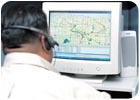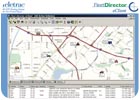
A fleet management system can provide a boost to productivity.
Dallas, Texas-based Water, Earth Solutions & Technologies Inc. (W.E.S.T.) is a service-oriented, highly diversified, environmental consulting and services company. Established in 1990, W.E.S.T. now offers services in six major categories. These include drilling services, asbestos, site assessments, environmental compliance, bio augmentation and remediation and petroleum storage tank programs. The company's primary service area includes large portions of northern, central and western Texas.
Site assessment services are a major part of the company's business. Today, owners, buyers and lenders now routinely investigate properties to determine past land-use practices and the present environmental conditions. These procedures provide the necessary documentation to reveal any areas and types of contamination, along with identifying the potential for costly remediation activities. Either the absence or presence of soil and/or ground water contamination will affect the property's long-term value and the potential for future uses. Some common examples of contamination that may be found include petroleum-based fuels or motor oil, pesticide residue, fertilizers and heavy metals.

A wide range of useful reports can be generated.
Three-phase Strategy
W.E.S.T. employs a detailed three-phase approach to these assessments. The Phase I environmental assessment consists of the initial site investigation using either of the current formats that conform to ASTM E-1527-00, ASTM E-1527-05 or the All Appropriate Inquiry (AAI). After November 1, 2006, parties must comply with the requirements of AAI Final Rule or follow the standards set forth in the ASTM E-1527-05 Phase I Environmental Site Assessment Process, to satisfy the statutory requirements for conducting all appropriate inquiries. All appropriate inquiries must be conducted in compliance with either of these standards in order to obtain protection from potential liability as an innocent landowner, a contiguous property owner or a bona fide prospective purchaser.Phase II assessments characterize and delineate any identified soil and water areas that are impacted. A detailed sampling plan then is developed. This may include site characterization, hydrogeological evaluations, monitor well installation and sampling, soil and water sampling, lab analysis, waste characterizations, observations and results, remedial alternatives and cost estimates.
Phase III consists of the supplying the necessary services to remediate to site.
Assessment Implementation
Once the site assessment plan is completed, the company's drilling arm goes into action. This plan identifies the number of holes required, and the depth, diameter and locations of the holes.Robert Flair manages W.E.S.T. Drilling, the division charged with carrying out the drilling portion of the various site assessments. Flair is responsible for scheduling the drilling rigs and crews, and preparing the list of equipment and supplies that are required for each assignment.
The types of environmental and geotechnical drilling services offered by W.E.S.T. Drilling:
- air- or wash-rotary drilling
- hollow-stem auger with CME continuous sampling
- continuous flight auger
- shelby tube sampling
- split-spoon sampling
- standard penetration tests
- THD cone penetration tests
- monitoring well installations
- recovery well installations
W.E.S.T. Drilling's employees are highly trained professionals. The company's stringent requirements include having all drillers receive 40 hours of OSHA-approved training, annual refresher training courses, and being licensed by the State of Texas. Supervisors have additional training requirements that include passing the Hazardous Waste Supervisor Training Course. Each assignment requires a truck-mounted drill and a support vehicle used for towing a trailer-mounted steam-cleaner unit and hauling other necessary equipment, such as soil container drums. The crew consists of a certified driller, drilling assistant and a helper.
According to Flair, the high value of the drilling and support equipment requires a substantial per-job fee. “Therefore, it's imperative we have the rigs on site, on time,” says Flair. He continues: “Many times, we work in large sections of undeveloped property. The client may be there, too, but he might be clear on the other side of the site, maybe a mile away. We needed a fleet management system that would show us exactly where the drilling rig was, as well as when it arrived or if it was still en route. We also needed to be able to account for the time the units actually were drilling and when they left a jobsite.”
The Technology Solution
W.E.S.T. owner Steven Wemple began investigating various vehicle tracking and fleet management systems. He chose the Teletrac FleetDirector system. Wemple explains, “Each of our drilling rigs and their support equipment represents a $400,000 investment. I wanted to know where my units are, which meant I needed GPS. I also wanted a management feature that would provide detailed reports about how the vehicles were being operated and by whom.”Since the system has been installed, W.E.S.T. Drilling has real-time information on each unit's location and status. The location information, delivered over the Internet, is viewed on any one of several map screens. The vehicles' entire routes, or any portion thereof, may be viewed. The screens also provide vehicle speed and direction information.
Flair notes several advantages the tracking system delivers when the equipment is out in the field. “Now, when we have a client say he can't find our rig at the site, I can tell him exactly where the unit is,” he explains. “That eliminates the issue of someone saying our truck wasn't there or that they were late. On the flip side, if we see that a unit has been delayed by traffic, we can call ahead and inform the client about the delay.
“Each of the drilling rigs has two engines - one for the truck chassis and a separate 'pony' engine that powers the actual drilling equipment. With FleetDirector, we know when the ignition is on and off. When the unit arrives on site, we know the main engine was shut off so that it is not wasting fuel idling. When the drill engine starts, the ignition-on indicator lets us know when drilling has commenced.”
W.E.S.T. Drilling also has been able to make sure that on-duty crews are where they're supposed to be. When they complete a job, they are supposed to return to the shop to prepare the rigs for the next day's job or work on various assignments in the shop. Flair said it didn't take long for the word to get out among the crews. “Shortly after we installed the system,” he says, “one crew hadn't shown up when they should have. I checked FleetDirector and I knew the job was completed and I knew when. Then, I pulled up the history screen and tracked the vehicle back from the job location to a location where there was no reason for them to be. You should have seen the looks on their faces when they finally showed up and I asked them how the scenery was at the spot where they were parked. From then on, taking the long way home hasn't been a problem.”
Fleet Management Perspective
FleetDirector's recording of vehicle location and operating information allows for the generation of numerous management reports. These can be created for individual drivers and vehicles or grouped for fleet-wide summaries. Vehicle speed, stationary times and route histories are just a few of the items that can be analyzed to improve productivity and reduce costs.Both Wemple and Flair agree the addition of Teletrac's FleetDirector has boosted overall productivity and provided important controls for monitoring fleet operations. All of W.E.S.T. Drilling's units are equipped with CME drills, which are mounted on either Ford or Freightliner chassis, with either single or dual axles. The company also is considering adding a track-mounted drill that can operate in more rugged locations.
ND
Report Abusive Comment